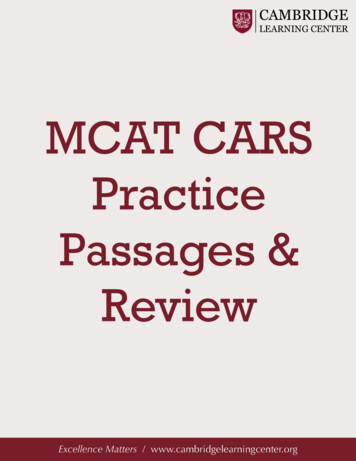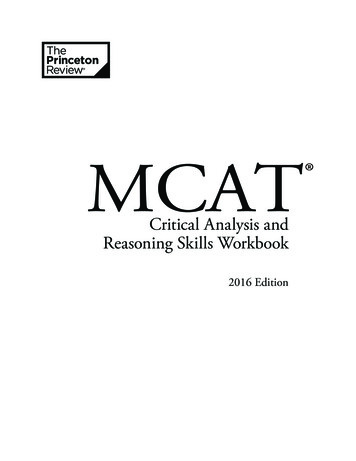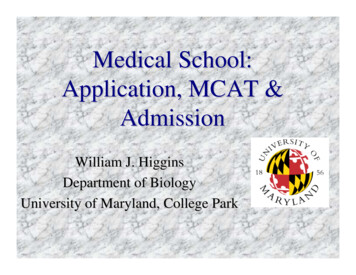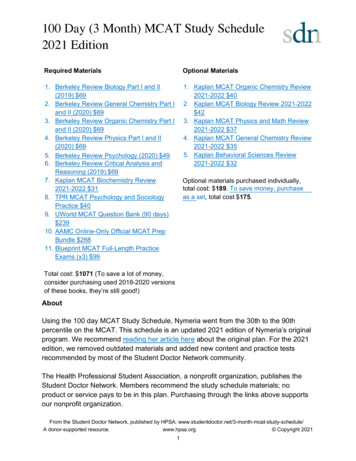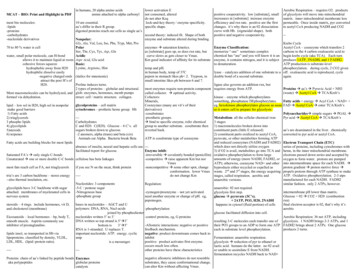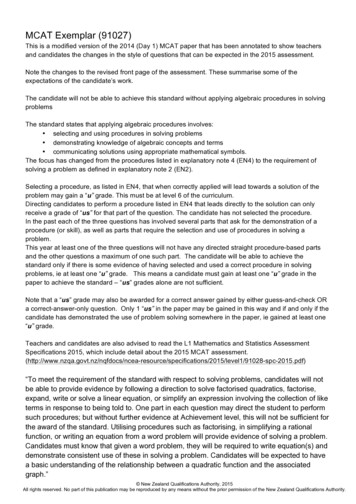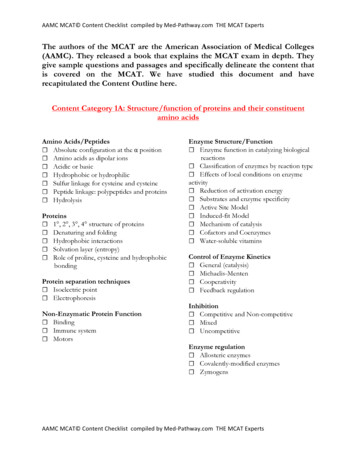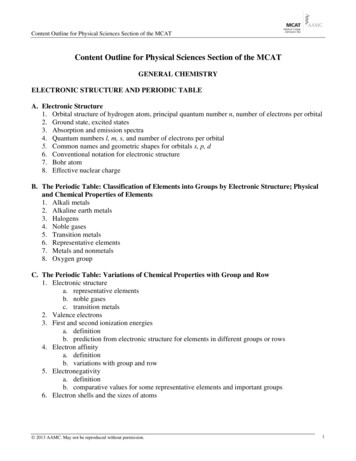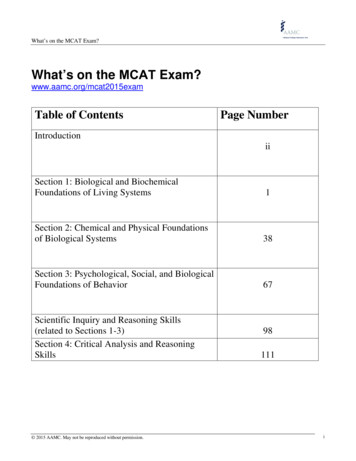
Transcription
What’s on the MCAT Exam?What’s on the MCAT Exam?www.aamc.org/mcat2015examTable of ContentsPage NumberIntroductioniiSection 1: Biological and BiochemicalFoundations of Living Systems1Section 2: Chemical and Physical Foundationsof Biological Systems38Section 3: Psychological, Social, and BiologicalFoundations of Behavior67Scientific Inquiry and Reasoning Skills(related to Sections 1-3)Section 4: Critical Analysis and ReasoningSkills 2015 AAMC. May not be reproduced without permission.98111i
What’s on the MCAT Exam?IntroductionThis document draws from the online resource What’s on the MCAT Exam? atwww.aamc.org/mcat2015exam. It contains a complete description of the competenciesyou are responsible for knowing on the MCAT2015 exam. It describes the new exam’scontent and format. It also lists and discusses the new exam’s conceptual framework ―which is organized around foundational concepts, content categories, and scientific inquiryand reasoning skills. Also included are sample test questions that demonstrate how thecompetencies are tested on the exam.While the content is written for you, the prospective MCAT examinee, the information itprovides is likely to be useful to pre-health advisors, other baccalaureate faculty, medicalschool admission officers, and medical schools.How is the MCAT Exam Structured?The MCAT exam has four test sections: Biological and Biochemical Foundations of Living Systems Chemical and Physical Foundations of Biological Systems Psychological, Social, and Biological Foundations of Behavior Critical Analysis and Reasoning SkillsThe first three sections are organized around foundational concepts or “big ideas” in thesciences. They reflect current research about the most effective ways for students to learn anduse science, emphasizing deep knowledge of the most important scientific concepts overknowledge simply of many discrete scientific facts.Leaders in science education say that some of the most important foundational concepts in thesciences ask students to integrate and analyze information from different disciplines. In thatvein, questions in these sections will ask you to combine your scientific knowledge frommultiple disciplines with your scientific inquiry and reasoning skills. You will be asked todemonstrate four different scientific inquiry and reasoning skills on the exam: Knowledge of scientific concepts and principles Scientific reasoning and problem solving Reasoning about the design and execution of research Data-based and statistical reasoningThe fourth section of the MCAT exam, Critical Analysis and Reasoning Skills, will be similar tomany of the verbal reasoning tests you have taken in your academic career. It includespassages and questions that test your ability to comprehend and analyze what you read. TheCritical Analysis and Reasoning Skills section asks you to read and think about passages from 2015 AAMC. May not be reproduced without permission.ii
What’s on the MCAT Exam?a wide range of disciplines in the social sciences and humanities, including those in populationhealth, ethics and philosophy, and studies of diverse cultures. Passages are followed by aseries of questions that lead you through the process of comprehending, analyzing, andreasoning about the material you have read. This section is unique because it has beendeveloped specifically to measure the analytical and reasoning skills you will need to besuccessful in medical school. 2015 AAMC. May not be reproduced without permission.iii
What’s on the MCAT Exam? Biological and Biochemical Foundations of Living SystemsWhat will the Biological and Biochemical Foundations of Living Systems Section Test?The Biological and Biochemical Foundations of Living Systems section asks you to solve problems bycombining your knowledge of biological and biochemical concepts with your scientific inquiry andreasoning skills. This section tests processes that are unique to living organisms, such as growing andreproducing, maintaining a constant internal environment, acquiring materials and energy, sensing andresponding to environmental changes, and adapting. It also tests how cells and organ systems within anorganism act independently and in concert to accomplish these processes, and it asks you to reasonabout these processes at various levels of biological organization within a living system.This section is designed to: test introductory-level biology, organic chemistry, and inorganic chemistry concepts;test biochemistry concepts at the level taught in many colleges and universities in first-semesterbiochemistry courses;test cellular and molecular biology topics at the level taught in many colleges and universities inintroductory biology sequences and first-semester biochemistry courses;test basic research methods and statistics concepts described by many baccalaureate faculty asimportant to success in introductory science courses; andrequire you to demonstrate your scientific inquiry and reasoning, research methods, and statisticsskills as applied to the natural sciences.Test SectionBiological and BiochemicalFoundations of Living SystemsNumber of Questions59(note that questions are acombination of passage-basedand discrete questions) 2015 AAMC. May not be reproduced without permission.Time95 minutes1
What’s on the MCAT Exam? Biological and Biochemical Foundations of Living SystemsScientific Inquiry and Reasoning SkillsAs a reminder, the scientific inquiry and reasoning skills that you will be asked to demonstrate on thissection of the exam are:Knowledge of Scientific Concepts and Principles Demonstrating understanding of scientific concepts and principlesIdentifying the relationships between closely-related conceptsScientific Reasoning and Problem Solving Reasoning about scientific principles, theories, and modelsAnalyzing and evaluating scientific explanations and predictionsReasoning about the Design and Execution of Research Demonstrating understanding of important components of scientific researchReasoning about ethical issues in researchData-Based and Statistical Reasoning Interpreting patterns in data presented in tables, figures, and graphsReasoning about data and drawing conclusions from them 2015 AAMC. May not be reproduced without permission.2
What’s on the MCAT Exam? Biological and Biochemical Foundations of Living SystemsGeneral Mathematical Concepts and TechniquesIt’s important for you to know that questions on the natural, behavioral, and social sciences sectionswill ask you to use certain mathematical concepts and techniques. As the descriptions of the scientificinquiry and reasoning skills suggest, some questions will ask you to analyze and manipulate scientificdata to show that you can Recognize and interpret linear, semilog, and log-log scales and calculate slopes from datafound in figures, graphs, and tables Demonstrate a general understanding of significant digits and the use of reasonable numericalestimates in performing measurements and calculations Use metric units, including converting units within the metric system and between metric andEnglish units (conversion factors will be provided when needed), and dimensional analysis(using units to balance equations) Perform arithmetic calculations involving the following: probability, proportion, ratio,percentage, and square-root estimations Demonstrate a general understanding (Algebra II level) of exponentials and logarithms(natural and base 10), scientific notation, and solving simultaneous equations Demonstrate a general understanding of the following trigonometric concepts: definitions ofbasic (sine, cosine, tangent) and inverse (sin‒1, cos‒1, tan‒1) functions; sin and cos values of 0 ,90 , and 180 ; relationships between the lengths of sides of right triangles containing angles of30 , 45 , and 60 Demonstrate a general understanding of vector addition and subtraction and the right-hand rule(knowledge of dot and cross products is not required)Note also that an understanding of calculus is not required, and a periodic table will be providedduring the exam. 2015 AAMC. May not be reproduced without permission.3
What’s on the MCAT Exam? Biological and Biochemical Foundations of Living SystemsReferencesDuring the actual exam, you will have access to the periodic table below while answering questions inthis section of the exam. 2015 AAMC. May not be reproduced without permission.4
What’s on the MCAT Exam? Biological and Biochemical Foundations of Living SystemsBiological and Biochemical Foundations of Living Systems Distribution of Questions byDiscipline, Foundational Concept, and Scientific Inquiry and Reasoning SkillYou may wonder how much biochemistry you’ll see on this section of the MCAT exam, how manyquestions you’ll get about a particular foundational concept, or how the scientific inquiry and reasoningskills will be distributed on your exam. The questions that you see are likely to be distributed in theways described below. These are the approximate percentages of questions you’ll see on a test for eachdiscipline, foundational concept, and scientific inquiry and reasoning skill.*Discipline: First-semester biochemistry, 25% Introductory biology, 65% General chemistry, 5% Organic chemistry, 5%Foundational Concept: Foundational Concept 1, 55% Foundational Concept 2, 20% Foundational Concept 3, 25%Scientific Inquiry and Reasoning Skill: Skill 1, 35% Skill 2, 45% Skill 3, 10% Skill 4, 10%*These percentages have been approximated to the nearest 5% and will vary from one test to another fora variety of reasons. These reasons include, but are not limited to, controlling for question difficulty,using groups of questions that depend on a single passage, and using unscored field-test questions oneach test form. 2015 AAMC. May not be reproduced without permission.5
What’s on the MCAT Exam? Biological and Biochemical Foundations of Living SystemsBiological and Biochemical Foundations of Living Systems Framework of FoundationalConcepts and Content CategoriesFoundational Concept 1: Biomolecules have unique properties that determine how they contribute tothe structure and function of cells and how they participate in the processes necessary to maintain life.The content categories for this foundational concept include1A. Structure and function of proteins and their constituent amino acids1B. Transmission of genetic information from the gene to the protein1C. Transmission of heritable information from generation to generation and the processes thatincrease genetic diversity1D. Principles of bioenergetics and fuel molecule metabolismFoundational Concept 2: Highly-organized assemblies of molecules, cells, and organs interact tocarry out the functions of living organisms.The content categories for this foundational concept include2A. Assemblies of molecules, cells, and groups of cells within single cellular and multicellularorganisms2B. The structure, growth, physiology, and genetics of prokaryotes and viruses2C. Processes of cell division, differentiation, and specializationFoundational Concept 3: Complex systems of tissues and organs sense the internal and externalenvironments of multicellular organisms, and through integrated functioning, maintain a stableinternal environment within an ever-changing external environment.The content categories for this foundational concept include3A. Structure and functions of the nervous and endocrine systems and ways in which these systemscoordinate the organ systems3B. Structure and integrative functions of the main organ systems 2015 AAMC. May not be reproduced without permission.6
What’s on the MCAT Exam? Biological and Biochemical Foundations of Living SystemsHow Foundational Concepts and Content Categories Fit TogetherThe MCAT exam asks you to solve problems by combining your knowledge of concepts with yourscientific inquiry and reasoning skills. Figure 1 illustrates how foundational concepts, contentcategories, and scientific inquiry and reasoning skills intersect to create test questions.Foundational Concept 1Foundational Concept yCategoryCategoryCategoryCategoryCategory1B1C2A at which foundational2B2C Each cell representsthe point1ASkill 1Skill 2Skill 3 concepts, content categories, and scientific inquiry andreasoning skills cross.Test questions are written at the intersections of theknowledge and skills.Skill 4 2015 AAMC. May not be reproduced without permission.7
What’s on the MCAT Exam? Biological and Biochemical Foundations of Living SystemsUnderstanding the Foundational Concepts and Content Categories in the Biological andBiochemical Foundations of Living Systems SectionThe following are detailed explanations of each foundational concept and related content categories tested in theBiological and Biochemical Foundations of Living Systems section. To help you prepare for the MCAT exam, weprovide content lists that describe specific topics and subtopics that define each content category for this section.The same content lists are provided to the writers who develop the content of the exam. Here is an excerpt fromthe content list.EXCERPT FROM BIOLOGICAL AND BIOCHEMICAL FOUNDATIONS OF LIVING SYSTEMSOUTLINEMetabolism of Fatty Acids and Proteins (BIO, BC) TopicDescription of fatty acids (BC)SubtopicDigestion, mobilization, and transport of fatsOxidation of fatty acidso Saturated fatso Unsaturated fatsKetone bodies (BC)Anabolism of fats (BIO)Non-template synthesis: biosynthesis of lipids and polysaccharides (BIO)Metabolism of proteins (BIO)The abbreviations in parentheses indicate the courses in which undergraduate students at many colleges anduniversities learn about the topics and associated subtopics. The course abbreviations are BC: first-semester biochemistryBIO: two-semester sequence of introductory biologyGC: two-semester sequence of general chemistryOC: two-semester sequence of organic chemistryIn preparing for the
content and format. It also lists and discusses the new exam’s conceptual framework ― which is organized around foundational concepts, content categories, and scientific inquiry and reasoning skills. Also included are sample test questions that demonstrate how the competencies are tested on the exam. While the content is written for you, the prospective MCAT examinee, the information it .

